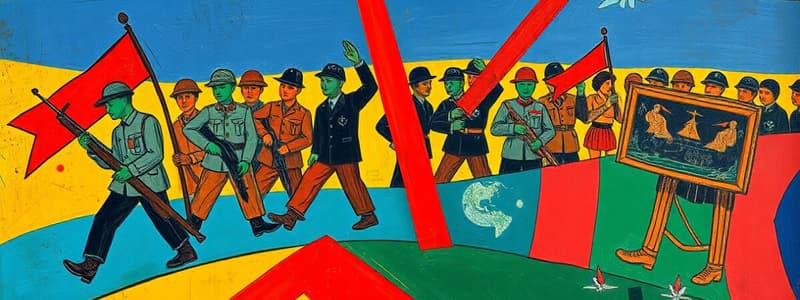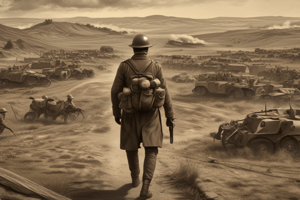Podcast
Questions and Answers
Alliances between countries can cause conflicts to remain simple.
Alliances between countries can cause conflicts to remain simple.
False (B)
World War I started on June 28, 1914.
World War I started on June 28, 1914.
False (B)
Over 22 million people were wounded as a result of World War I.
Over 22 million people were wounded as a result of World War I.
True (A)
Russia experienced the highest casualties in World War I with 1.7 million deaths.
Russia experienced the highest casualties in World War I with 1.7 million deaths.
Modern technology had no significant impact on the course of World War I.
Modern technology had no significant impact on the course of World War I.
World War I had no effects on the civilian population of the countries involved.
World War I had no effects on the civilian population of the countries involved.
The concept of winning a war raises ethical questions about the costs associated with victory.
The concept of winning a war raises ethical questions about the costs associated with victory.
After World War I, all European nations experienced only positive changes in their national identity and borders.
After World War I, all European nations experienced only positive changes in their national identity and borders.
Militarism refers to a belief that a country should have a strong and aggressive military.
Militarism refers to a belief that a country should have a strong and aggressive military.
The Alliance System was designed to encourage countries to fight against each other.
The Alliance System was designed to encourage countries to fight against each other.
Germany had the highest defense expenditure at 73% among the Great Powers.
Germany had the highest defense expenditure at 73% among the Great Powers.
Nationalism is one of the key factors contributing to World War I.
Nationalism is one of the key factors contributing to World War I.
Imperialism refers to the desire of countries to reduce their military capacities.
Imperialism refers to the desire of countries to reduce their military capacities.
Extreme pride in one’s nation is a characteristic of nationalism.
Extreme pride in one’s nation is a characteristic of nationalism.
Countries competing for raw materials did not contribute to the tensions leading to WW1.
Countries competing for raw materials did not contribute to the tensions leading to WW1.
The Assassination factor in the acronym M.A.N.I.A is related to increased military spending.
The Assassination factor in the acronym M.A.N.I.A is related to increased military spending.
Pan-Slavism was a unifying movement primarily found in Western Europe.
Pan-Slavism was a unifying movement primarily found in Western Europe.
Alliances often escalated tensions among nations during the build-up to World War I.
Alliances often escalated tensions among nations during the build-up to World War I.
France's defense expenditures amounted to 10%, making it the highest among Great Powers.
France's defense expenditures amounted to 10%, making it the highest among Great Powers.
The desire for ethnic groups to self-govern was a major cause of conflict before WW1.
The desire for ethnic groups to self-govern was a major cause of conflict before WW1.
Great Britain and France both had significant empires in Asia and Africa during the lead-up to WW1.
Great Britain and France both had significant empires in Asia and Africa during the lead-up to WW1.
Flashcards
Militarism
Militarism
The belief that a country should have a strong military to defend and promote its interests.
Arms Race
Arms Race
The competition between countries to build up their military power, including armies, navies, and weapons.
Causes of War
Causes of War
Reasons why countries declare war on each other; often include complex political relationships, economic rivalries, and technological advancements.
Alliance System
Alliance System
Signup and view all the flashcards
World War 1 - Start Date
World War 1 - Start Date
Signup and view all the flashcards
Nationalism
Nationalism
Signup and view all the flashcards
World War 1 - End Date
World War 1 - End Date
Signup and view all the flashcards
Imperialism
Imperialism
Signup and view all the flashcards
War Casualties
War Casualties
Signup and view all the flashcards
Assassination
Assassination
Signup and view all the flashcards
Modern Warfare Technology
Modern Warfare Technology
Signup and view all the flashcards
National Identity
National Identity
Signup and view all the flashcards
Triple Entente
Triple Entente
Signup and view all the flashcards
Triple Alliance
Triple Alliance
Signup and view all the flashcards
Imperialism
Imperialism
Signup and view all the flashcards
Impact of War on Citizens
Impact of War on Citizens
Signup and view all the flashcards
Nationalism's Role in WWI
Nationalism's Role in WWI
Signup and view all the flashcards
Imperial Rivalry in WWI
Imperial Rivalry in WWI
Signup and view all the flashcards
Assassination's Impact on WWI
Assassination's Impact on WWI
Signup and view all the flashcards
European Conflict Factors
European Conflict Factors
Signup and view all the flashcards
Powder Keg of Europe
Powder Keg of Europe
Signup and view all the flashcards
Study Notes
Enduring Understandings (EUs)
- Alliances between countries can escalate simple conflicts.
- Technology and modern warfare contributed to World War 1 becoming a global conflict.
- All citizens of the involved countries were affected by World War I.
- No one wins in a war.
Enduring Questions (EQs)
- What differentiates one nation's identity from another?
- What led to Western dominance and the imperialization of other nations?
- How can new ideas accelerate economic and political change?
- Are you willing to win at all costs?
World War I Facts
- Started on July 28, 1914.
- Ended November 11, 1918.
- Almost 8 million died due to the war.
- Russia suffered the most casualties with 1.7 million deaths.
- Approximately 22 million people were wounded.
Causes of World War I (MANIA)
- Militarism: A belief that a country must have a strong military to protect its interests. This involved increased military spending and the growth of mass armies and navies.
- Alliances: Agreements between countries promising mutual support if attacked. These alliances created a complex web of obligations, escalating conflicts.
- Nationalism: Intense pride and devotion to one's nation. This led to competition and tension between countries.
- Imperialism: Countries competing for colonies and resources. This fueled rivalry and conflicts.
- Assassination of Archduke Franz Ferdinand: The assassination of the heir to the Austro-Hungarian throne sparked a chain of events that ultimately led to the war.
Studying That Suits You
Use AI to generate personalized quizzes and flashcards to suit your learning preferences.




